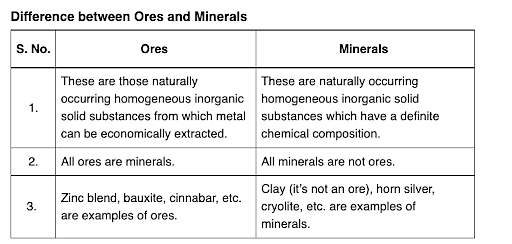2[Au(CN)2]– + Zn \(\to\) [Zn(CN)4]2– + 2Au\(\downarrow\) is which of these
(A) Redox reaction
(B) Displacement reaction
(C) Combination reaction
(D) Decomposition reaction
2[Au(CN)2]– + Zn \(\to\) [Zn(CN)4]2– + 2Au\(\downarrow\) is which of these
(A) Redox reaction
(B) Displacement reaction
(C) Combination reaction
(D) Decomposition reaction
- A & B
- B only
- A & D
- B & D
The Correct Option is A
Solution and Explanation
The correct answer is A & B:
\[ 2[\text{Au(CN)}_2]^– + \text{Zn} \to [\text{Zn(CN)}_4]^{2–} + 2\text{Au} \]
This reaction involves the reduction of gold (\(Au\)) and the oxidation of zinc (\(Zn\)), making it a:
- Redox reaction: Gold is reduced, and zinc is oxidized.
- Displacement reaction: Zinc displaces gold from its complex.
Top Questions on General Principles and Processes of Isolation of Elements
- In the extraction of iron using blast furnace to remove the impurity (X), chemical (Y) is added to the ore. X and Y are respectively
- TS EAMCET - 2025
- Chemistry
- General Principles and Processes of Isolation of Elements
- What is used for the Thermite Reaction?
- BCECE - 2025
- Chemistry
- General Principles and Processes of Isolation of Elements
- Which of the following compounds is used to cover the surface of a metallic object to prevent corrosion?
- KEAM - 2025
- Chemistry
- General Principles and Processes of Isolation of Elements
A block of mass 1 kg is pushed up a surface inclined to horizontal at an angle of \( 60^\circ \) by a force of 10 N parallel to the inclined surface. When the block is pushed up by 10 m along the inclined surface, the work done against frictional force is:

[Given: \( g = 10 \) m/s\( ^2 \), \( \mu_s = 0.1 \)]
- BITSAT - 2024
- Physics
- General Principles and Processes of Isolation of Elements
A parallel plate capacitor with plate area \(A\) and plate separation \(d = 2\) m has a capacitance of \(4\mu F\). The new capacitance of the system if half of the space between them is filled with a dielectric material of dielectric constant \(K = 3\) (as shown in the figure) will be:

- BITSAT - 2024
- Physics
- General Principles and Processes of Isolation of Elements
Questions Asked in JEE Main exam
The magnitude of heat exchanged by a system for the given cyclic process ABC (as shown in the figure) is (in SI units):

- JEE Main - 2025
- Electric charges and fields
- The value of \( (\sin 70^\circ)(\cot 10^\circ \cot 70^\circ - 1) \) is:
- JEE Main - 2025
- Trigonometric Identities
- The number of 6-letter words, with or without meaning, that can be formed using the letters of the word "MATHS" such that any letter that appears in the word must appear at least twice is:
- JEE Main - 2025
- Calculus
- 10 mL of 2 M NaOH solution is added to 20 mL of 1 M HCl solution kept in a beaker. Now, 10 mL of this mixture is poured into a volumetric flask of 100 mL containing 2 moles of HCl and made the volume upto the mark with distilled water. The solution in this flask is :
- JEE Main - 2025
- Solutions
Consider the following sequence of reactions :

Molar mass of the product formed (A) is ______ g mol\(^{-1}\).- JEE Main - 2025
- Organic Chemistry
Concepts Used:
General Principles and Processes of Isolation of Elements
What are Ores and Minerals?
Minerals are the naturally occurring, homogeneous inorganic solid substances. They are having a definite chemical composition and crystalline structure, hardness and color. For example, copper pyrite, calamine, etc.

Impurities in an ore are called gauge. The removal of a gauge from the ore is called concentration ore.
Several steps are involved in the extraction of pure metal from ores. Major steps are as follows –
- Concentration of the ore
- Isolation of the metal from its concentrated ore
- Purification of the metal